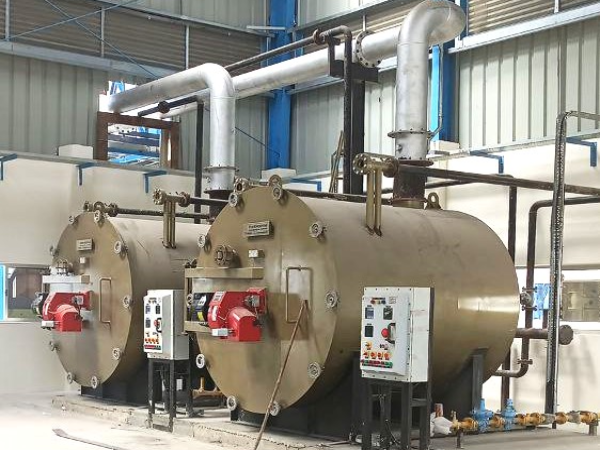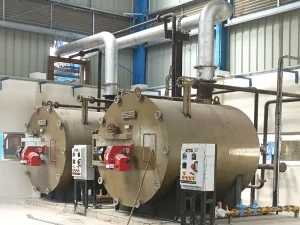Industrial Thermic Fluid Heater for Consistent, Safe & Efficient Process Heating
Thermic fluid heater - FLUIDTHERM
Thermic Fluid Heater is heating equipment, used in industrial applications requiring high-temperature heating at low pressures.
Thermic Fluid heaters are closed-loop systems, where the thermic fluid is heated in a specially designed heat exchanger through a controlled combustion of fuel. Hot oil is pumped through a high-temperature pump into the pipeline circuits, and gets circulated back to the heater, where it is heated again.
Our Thermic fluid heaters are designed for many fuel options like oil, gas, biomass, coal, wood, etc.
1 lac Kcal/hr to 60 Lac Kcal/hr
- All Biomass fuels
- Rice husk
- Briquettes
- Coal
- Agro-waste
- Wood & wood chips
- Light oil
- Heavy oil
- PNG
- LPG
- Biogas
- Oil fired
- Gas fired
- Dual fuel fired (Oil cum gas)
- Manual
- Fluidised Bed Combustion
- Automatic feeding
- Textiles
- Namkeen
- Food processing
- Chemicals
- Rubber and other
Thermic fluid heater related FAQs-
A thermic fluid heater (TFH) uses a heat transfer fluid (thermal oil) to indirectly deliver heat to industrial processes. Unlike steam boilers, TFHs operate at low pressure even at high temperatures (up to 400°C), making them safer for applications like chemical processing, textiles, and food production. The closed-loop system ensures continuous heat circulation without fluid loss.
TFHs support multiple fuels:
- Natural gas: Affordable, efficient, and low-emission but subject to price fluctuations.
- Diesel: High energy content but produces higher emissions.
- Coal/Solid fuels: Cost-effective for large-scale operations.
- Biomass: Eco-friendly option gaining traction in sustainable industries.
Thermic fluid heaters are highly energy-efficient, optimizing fuel use to reduce operating costs. Their design minimizes heat loss, achieving thermal efficiencies up to 85-90% while maintaining precise temperature control (100°F–750°F).
Oil heaters (e.g., thermal oil systems) work via indirect heating:
- Fuel combustion generates heat in a chamber.
- Thermal oil absorbs heat and circulates through a closed loop.
- Heat exchangers transfer energy to processes.
- Cooled oil returns to the heater for reheating.
TFH stands for Thermic Fluid Heater.
Similar to TFHs, thermal oil boilers:
- Burn fuel to heat oil in a combustion chamber.
- Circulate oil via pumps to deliver heat.
- Maintain consistent temperatures without high-pressure risks.
Efficiency is typically calculated as:
Efficiency (%)=(Heat Output / Fuel Input)×100
Exact methods depend on system design and thermal fluid properties. Consult manufacturer guidelines for precise metrics.
Capacity depends on thermal load:
Q= m×Cp×ΔT
Where:
Q = Heat load (kW)
m = Mass flow rate of fluid (kg/s)
Cp = Specific heat of fluid (kJ/kg°C)
ΔT = Temperature difference (°C)
Safety: Low-pressure operation reduces explosion risks.
Precision: Stable temperature control (±1°C).
Versatility: Compatible with diverse fuels and high-temperature applications.
Cost-effective: Lower maintenance and fuel costs compared to steam systems.
For tailored solutions, consult manufacturers like thermodyne engineering systems to match specific industrial needs




